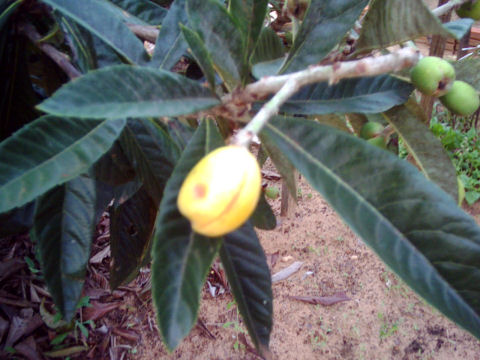

Eriobotrya japonica (Japanese Loquat)
The Japanese loquat is one to 23 feet tall evergreen tree. The loquats grow in bunchy multiple fruits, which are developing in the early spring. The pear-shaped pseudofruits are approx. 2 inches long aqnd have at the thickest part one diameter of approx. 1.6 inches. Its thin, lightyellow skin is finely haired and can be peeled easily. The pulp of the loquat is yellowish to orange-colored and according to different cultivars firm or soft. It is juicy and refreshing and has one sweetish-sour taste. If unripen, the fruit tastes very sour. Ripen fruits are recognized at small brown spots on the skin, they are no signs of fading. The loquat contains usually two to ten hard, smooth seeds, which are easy to germinate. The loquat is also hardy in the German speaking area in milder regions and are popular to grow outdoors by exotic gardeners, but they do fruit only in milder years. It is also hardy in milder and warmer parts of Ireland, U. K. and U.S.A.
The origin of the loquat lies in China, Japan and Taiwan. In China it occurs in the provinces Hubei and Sichuan, in Japan on Honshu, Kyushu and Shikoku. The loquat was introducted at the end of the 18th century to Europe and is grown in many countries with Mediterrean or subtropical climate, also in South America and Brazil.
The Japanese loquat was cultivated as ornamental plant at first. But it is grown more because of its fruits. Loquats can be eaten in-natura or cooked, with or without skin. Steamed are they especially aromatic. They are used mostly for fruit salads, cakes or as jelly or jam. The seeds are used grinded as spice.
The fruits of the Japanese loquat contain much calcium and vitamin A and are diuretc.

Japanese loquat in our yard in January 2009.

Close-up view of one fruit of our loquat in August 2009.
Back to the Agricultural Plant List
Created by Joachim Jaeck on December 1st, 2009